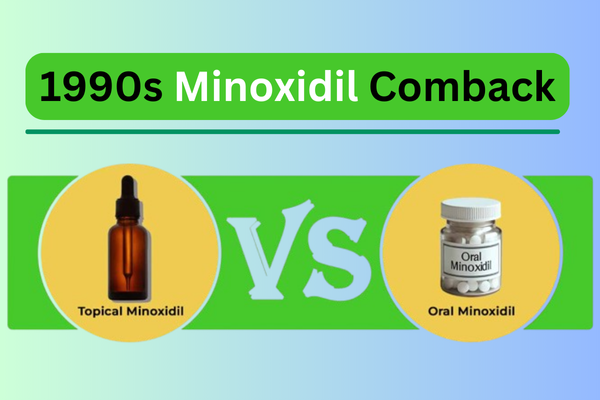Minoxidil: The 1990s Hair Growth Drug Making a Modern Comeback

Table of Contents
The Unexpected Breakthrough in Hair Growth Treatment
The latest innovation in hair loss treatment isn’t new—it’s actually a repurposed drug from the 1990s. Experts are now calling minoxidil a breakthrough for hair regrowth, and it’s gaining popularity in a new form: low-dose oral tablets.
Previously, minoxidil was widely recognized under the brand name Rogaine, a topical hair growth treatment that helped slow down thinning hair when applied directly to the scalp. However, dermatologists are now increasingly prescribing oral minoxidil, which appears to be more effective, convenient, and affordable for both men and women.
How Minoxidil Became a Hair Loss Solution
Minoxidil was originally developed in the 1970s as an oral medication for high blood pressure. Researchers soon observed an unexpected side effect—increased hair growth. This led to the development of a topical formulation, which was approved by the FDA in 1988 as the first drug for treating male pattern baldness. By 1991, a lower-dose version was also approved for women and heavily marketed through TV and print advertisements.
According to Dr. Adam Friedman, chair of dermatology at George Washington University, minoxidil works by increasing blood flow to the scalp, which helps keep hair follicles in their growth phase for longer. This mechanism is believed to be the key to its effectiveness in reducing hair loss and promoting hair regrowth
Oral Minoxidil vs. Topical Minoxidil: Which Is Better?
While minoxidil has been used as a topical solution for decades, recent studies suggest that taking it orally may be even more effective. Some of the advantages of oral minoxidil include:
Better Absorption: When taken as a pill for hair growth, the body absorbs minoxidil more efficiently than when applied topically.
Ease of Use: The oral tablet is taken once a day, whereas the liquid solution must be applied to the scalp once or twice daily.
Higher Compliance: Many users discontinue topical minoxidil due to its sticky texture and the inconvenience of daily application. Oral minoxidil offers a simpler alternative, increasing the likelihood of consistent use.
Safety and Side Effects of Oral Minoxidil
Minoxidil is typically prescribed in very low doses for hair regrowth treatment. Men are often advised to take half of the lowest-dose pill, while women may only require a quarter of a pill. These small doses help minimize potential side effects, which can include:
Dizziness
Rapid heartbeat
Swollen legs or ankles
Who Should Avoid Oral Minoxidil?
Oral minoxidil is not recommended for individuals with a history of heart disease or those who are pregnant or breastfeeding.
Why Hasn’t the FDA Approved Minoxidil Pills for Hair Loss?
Despite its effectiveness, oral minoxidil is not FDA-approved for hair loss. The primary reason is financial—since minoxidil’s patent has expired, pharmaceutical companies have little incentive to fund expensive clinical trials for a drug that is already available as an affordable generic medication.
Instead, dermatologists prescribe low-dose oral minoxidil off-label, using the same formulation initially intended for blood pressure treatment. This practice makes the medication widely accessible at a low cost, with some pharmacies offering a month’s supply for as little as $5.
The Role of Telehealth in Hair Loss Treatment
With only around 12,000 dermatologists in the U.S., finding a specialist for hair loss treatment can be challenging. This is where telehealth providers like Hims and Ro come in. These online hair loss treatment services offer quick access to hair regrowth medications by allowing users to fill out a simple medical questionnaire. A licensed healthcare provider then reviews the information and prescribes the appropriate medication, which is shipped directly to the customer’s door.
While telehealth services provide convenience, many dermatologists recommend in-person consultations for a comprehensive hair loss evaluation, including blood pressure monitoring and a discussion of potential side effects.
Conclusion: Is Oral Minoxidil the Future of Hair Loss Treatment?
Oral minoxidil is proving to be a cost-effective, convenient, and potentially more effective solution for hair loss compared to its topical counterpart. While it remains an off-label prescription, its increasing adoption by dermatologists and telehealth platforms suggests that it could become a mainstream treatment option.
If you’re considering oral minoxidil for hair regrowth, consult a board-certified dermatologist to discuss whether it’s the right option for you.
Frequently Asked Questions (FAQs)
1. Is Oral Minoxidil More Effective Than Topical Minoxidil?
Yes, many dermatologists believe that oral minoxidil works better because it is absorbed directly into the bloodstream, leading to more consistent results compared to topical solutions.
2. How Long Does It Take to See Results with Oral Minoxidil?
Most users start noticing improvements in hair growth within 3 to 6 months of consistent use. Full results may take up to a year.
3. Can Women Use Oral Minoxidil for Hair Growth?
Yes, low-dose oral minoxidil is often prescribed for female hair loss. However, women typically take smaller doses compared to men.
4. What Are the Side Effects of Oral Minoxidil?
The most common side effects of minoxidil pills include dizziness, swelling, and rapid heartbeat. However, these effects are rare when taken at low doses.
5. Where Can I Get Oral Minoxidil?
Oral minoxidil requires a prescription from a healthcare provider. It can be obtained through dermatologists, telehealth services, or local pharmacies.

